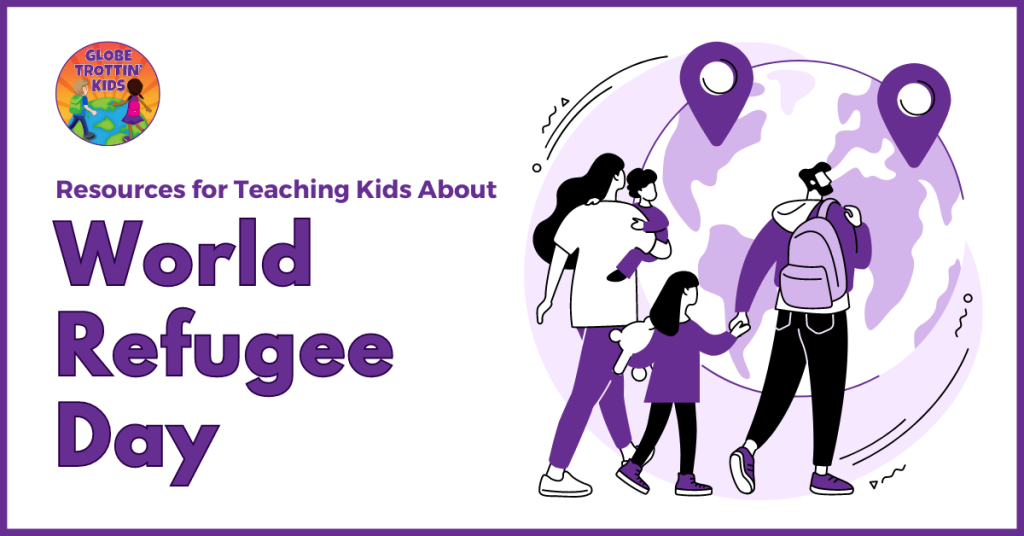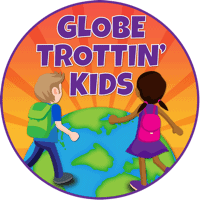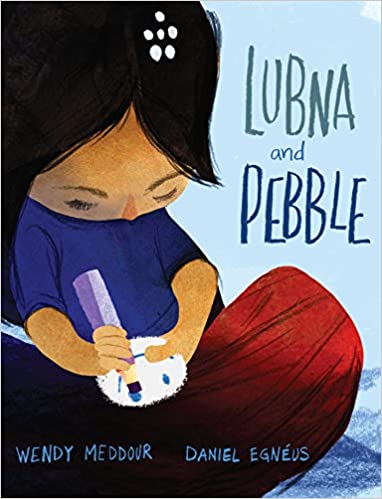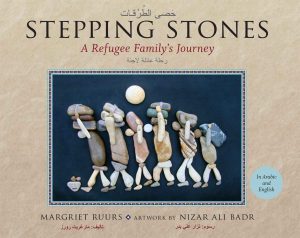World Refugee Day Resources & Activities for Kids
Refugees.
They are human beings.
Mothers and fathers.
Brothers and sisters.
Aunts and uncles.
Grandmas and grandpas.
Babies.
Toddlers and kids.
Tweens and teens.
Friends.
Family.
25.9 million of our fellow humans have been forcibly displaced from their homes due to war, persecution, and violence.
They flee with the clothes on their backs and are often separated from their loved ones.
Camps become the first accommodation for millions of refugees, half of whom are children.

Disclosure: This post contains affiliate links. By clicking through and making a purchase, we receive a small commission at no extra charge to you. All proceeds help support our free global education website. Thank you!
World Refugee Day is held annually on June 20th to bring awareness to the plight of displaced humans around the globe.
It is also a day to commemorate refugees’ strength and resilience during the hardest times.
It is an opportunity for the world to think about human rights in the face of a global crisis and to protect children from suffering and instability.
June 20th is the day, but the time is always ripe for bringing awareness and instilling empathy in our youngest minds.
As educators, parents, and caregivers, we can do our part to educate children about the refugee crisis through appropriate and profound ways.
As you take on this moment to educate our youngest global learners, check out the resources we’ve gathered.
Facts & Figures
“Every minute 20 people leave everything behind to escape war, persecution, or terror.” Learn more about the types of forcibly displaced persons (refugee, asylum seeker, stateless, returnee) and the refugee rights that were enacted at the 1951 Refugee Convention. -United Nations
What countries are refugees fleeing? Which countries are hosting the most refugees? What are the global trends by region/country? Check out Figures At a Glance and Refugee Statistics from UNHCR (aka the UN Refugee Agency).
Who is a Refugee?
Explore additional animations and resources from UNHCR, including Refugee Rights and Who Helps Refugees?
The Refugee Experience
A photo essay from Syrian refugee children portrays what life is like in a tent settlement in Lebanon.
“What is it like to have no home?” British children and child refugees ask and answer questions about the refugee crisis.
What’s in My Bag? What Refugees Bring When They Run for Their Lives A mother, a child, a teenager, a pharmacist, an artist, and a family share the contents of their bags and what they managed to carry from their homes. Their choices tell stories from their past and share hopes for their future.
Conversation Starter: “What would you bring, and why?”
Books & Activities
When Lubna is forced to flee her home with her father, she picks up a pebble on the beach to take with her. Lubna draws a smiley face on her pebble, they become best friends. Along with her father, the pebble becomes her source of strength and comfort.
Upon arriving at a refugee camp, Lubna cares for her pebble and creates a special bed for it. One day, a scared and lonely boy named Amir arrives at the camp. They become fast friends as children do. When the time comes for Lubna and her father to leave, Lubna worries that Amir will once again be lonely. She comes to realize that her new friend may need Pebble more than she does.
This book is so precious. It not only teaches children how their lives may be different, but it also teaches them how their lives might be similar.
Lubna’s pebble is a symbol of comfort, like a baby’s lovey or a child’s teddy. It represents something safe and steady. When Lubna gives her comfort to someone else, we see an unselfish act of love. Teaching kids to give comfort to others in times of need is a sure way to peace.
Lubna’s pebble was her best friend. It was her source of comfort when she felt scared and alone. She drew a smiley face on her rock to bring her joy when her heart was sad.
When Lubna realized her new friend at the refugee camp needed her pebble more than she did, she gave her special rock to him so that he could find comfort too.
Activity: Create a special rock for someone like Lubna and Amir. Someone who might need a little extra love and care. Check out The Kindness Rocks Project, and discover more ways to add a little sunshine to someone’s day.
Stepping Stones: A Refugee Family’s Journey
Stepping Stones is a beautifully written account of one family’s journey to freedom. Before fleeing their war-torn country, Rama, a young Syrian girl, shares the beauty of their home, garden, and peaceful way of life. Rama tells of joyous mornings when the rooster crows to wake them from their sleep. She creates a happy breakfast scene in which mama prepares breakfast with fresh tomatoes from the garden. We can imagine her family’s traditions and daily rituals as she shares the memories of her once peaceful village.
As war and violence spread, Rama and her family are no longer free. No longer able to sing their own songs, pray their own prayers, and dance their own dances. When all their freedoms are gone, they know they must flee. They take only what they can carry on their backs. They walk a long walk, sail in a boat, plant flowers for those lost at sea, and hang onto hope.
When Rama and the others arrive on new land, they are greeted with kindness and love. Their new neighbors’ words are different, but Rama knows that in their hearts they speak the same language. A language of freedom. Rama now knows that once again there will be bright days ahead.
Discuss Rama’s experience. How did she feel during different parts of her journey? (Include examples from the story to support responses.)
It must be noted that the illustrations in this book tell so much of the story simply on their own.
The illustrator is Nizar Ali Badr, a Syrian artist, who creates stone sculptures in his hometown of Latakia, Syria. His place of inspiration is at the foot of Mount Zaphon, where he has collected thousands of pebble stones of various colors and sizes to create his art. The illustrations in Stepping Stones are photographs of Nizar Ali Badr’s interpretation of the story through stone sculpture.
Watch Nizar Ali Badr at work here as he sculpts images from the book:
Dreamers written and illustrated by Yuyi Morales
Caldecott Honor artist, Yuyi Morales, shares her journey as a young mother who immigrated from Mexico to the United States with her infant son. She left behind nearly everything she had to create something new.
This is a true story of a mother and son who find themselves immersed in a new land, with new words, and lots of mistakes. One day, they find themselves in an unimaginable place. A place that is suspicious and surprising. A place where they didn’t need to speak. It was the library that became the place where they would learn. Books became their home, their language, and their life. They dreamed of a brilliant future that would someday be. In the midst of their dreams, they also remembered their story. That they are two languages. That they are hope, resilience, and sonãdores of the world.
This book is written in English with bits of Spanish that symbolize how Yuyi and her son are two languages. Every page is filled with images that depict two cultures and two stories.
She uses elements of Mexican folk art in her illustrations to bring her heritage to life. It’s so beautiful that through her art, we see both the journey and the dream, as she saw it.
- Meet Yuyi, the author and illustrator of Dreamers, and hear her immigration story.
- Download the Dreamers Educators Guide from Holiday House
Helping Hands
After introducing kids to the refugee crisis and understanding action is desperately needed, discuss ways to help.
Contact refugee services in your area to find out what their individual needs are – or suggest one of the following ideas as a way to contribute:
- Make Welcome Bags Fill a purse, backpack, or tote bag for new arrivals in your community. Include necessities, such as toiletries and school supplies, and then add in fun items such as stuffed animals and gift cards to local businesses. Add a personal touch with a decorated welcome sign or note from your family.
- Hold a Community Drive Collect new and gently-used clothing, books, toys, furniture, etc. to donate.
- Host a Fundraiser Lemonade stand. Bake sale. Car washing. Dog walking. Brainstorm ways to raise funds for refugee educational and/or social services.



